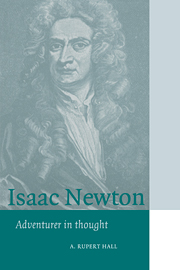Book contents
- Frontmatter
- Contents
- List of Figures
- General Editor's Preface
- Foreword
- Acknowledgement
- 1 The Hopeful Youth, 1642–1664
- 2 “The prime of my age for invention”, 1664–1667
- 3 Widening Horizons, 1667–1669
- 4 The Professor of Mathematics, 1669–1673
- 5 Publication and Polemic, 1672–1678
- 6 Life in Cambridge, 1675–1685
- 7 The Chemical Philosopher, 1669–1695
- 8 The Mathematical Principles of Natural Philosophy, 1679–1687
- 9 Private and Public life, 1685–1696
- 10 Fluxions and Fury, 1677–1712
- 11 Opticks, or a Treatise of Light, 1687–1704
- 12 Life in London, 1696–1718
- 13 A Man of Authority and Learning, 1692–1727
- 14 Later Books, 1706–1726
- 15 Kensington, 1725–1727
- Appendices
- Notes
- Bibliography
- Index
2 - “The prime of my age for invention”, 1664–1667
Published online by Cambridge University Press: 12 January 2010
- Frontmatter
- Contents
- List of Figures
- General Editor's Preface
- Foreword
- Acknowledgement
- 1 The Hopeful Youth, 1642–1664
- 2 “The prime of my age for invention”, 1664–1667
- 3 Widening Horizons, 1667–1669
- 4 The Professor of Mathematics, 1669–1673
- 5 Publication and Polemic, 1672–1678
- 6 Life in Cambridge, 1675–1685
- 7 The Chemical Philosopher, 1669–1695
- 8 The Mathematical Principles of Natural Philosophy, 1679–1687
- 9 Private and Public life, 1685–1696
- 10 Fluxions and Fury, 1677–1712
- 11 Opticks, or a Treatise of Light, 1687–1704
- 12 Life in London, 1696–1718
- 13 A Man of Authority and Learning, 1692–1727
- 14 Later Books, 1706–1726
- 15 Kensington, 1725–1727
- Appendices
- Notes
- Bibliography
- Index
Summary
“The same year I found the method of Tangents …”
The origins of Newton's principal innovations in mathematics and science are to be found in the records of his reading as an undergraduate; immediately after these studies came “the prime of my age for invention” which Newton placed in 1665 and 1666. In mathematics and optics the transition from reading to original investigation can be perceived (though not exactly dated). In mechanics, on the other hand, we find Newton's earliest discovery on the first page of his “Waste Book” (Cambridge University Library MS Add. 4004), where the tenth page is dated “Jan 20th 1664” (that is, 1665 in our reckoning). No known annotation from Galileo or any other likely source antedates the “Waste Book”. From this and other dates in the notebooks it is evident that Newton's great epoch of creative scientific work began some months before the start of the year 1665, while he continued to mine the rich veins that he had opened as late as (probably) 1668. The two years of Newton's reminiscences stretch more accurately to three or more, of which 1665 and 1666 were central and critical.
That a large portion of this creative epoch was passed in Lincolnshire – not by any means altogether at home in Woolsthorpe, but probably also at Grantham and certainly at Boothby Pagnell – was a matter of chance. Not for the first time, Cambridge University was closed by plague. Bubonic plague had been endemic in Britain since the great pandemic of the mid-fourteenth century; the last major outbreak had been in 1625.
- Type
- Chapter
- Information
- Isaac NewtonAdventurer in Thought, pp. 30 - 64Publisher: Cambridge University PressPrint publication year: 1996



